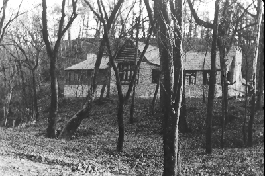
by Sherry Griffin & Renee Gray When Franklin D. Roosevelt accepted the Democratic presidential nomination in 1932, he made this statement-one which was to change forever the politics of the United States: "I pledge you, I pledge myself, to a new deal for the American people." It was clear to Roosevelt that something drastic had to be done about unemployment of youth and the waste of natural resources. By 1932 more than 5 million young men were unemployed, and World War I veterans in huge numbers were also without jobs. These men roamed the countryside looking for work, went on Welfare or turned to a life of crime. Millions of acres of farmland were eroded. Millions more were being threatened by fire or timber harvesting. Recreational opportunities in parks across the nation were being lost due to budget and personnel problems. 
National Archives Two days after Roosevelt's inauguration on March 4, 1933, the new president called a meeting of high government officials to create a Civilian Conservation Corps (CCC). The idea behind the CCC, as expressed by Congress, was "to relieve the acute condition of wide-spread distress and unemployment existing in the United States, provide for the restoration of the country's depleted natural resources, and advance an orderly program of useful public works." The CCC, an idea that occurred to President Roosevelt well before 1933, was to put up to 500,000 unemployed youths to work in forests, parks, and range lands. This "Tree Army" would be responsible for reforesting public lands, building roads, trails, bridges, and buildings in state and national parks and other public lands across America. The Army would run the camps. The Agriculture and Interior departments would be responsible for work projects and provide the personnel to manage them. 
Approximately 55% of all enrollees came from the rural communities of the country, and 45% from the cities. Camp life was far different from anything the enrollees had experienced. Many were away from home for the first time and were holding their first steady jobs. To urban youths the sudden transfer to a remote wilderness camp was a real culture shock. In addition, camp life was regimented; the enrollees had to follow a standard routine. No longer would he roam the streets of his hometown or the backwoods of his farm, or "ride the rails" in search of work. On the other hand, while pay of a $30 a month was hardly lavish, he did have some income for himself and was earning money for the family back home. ($25 of the pay was sent directly to the enrollee's family.) Most of the boys enrolling in the early days were underweight and undernourished. They gained an average of 11¼ pounds in their first three to four months in the CCC. The CCC at Ozark National Scenic Riverways The CCC workers at Big Spring completed extensive work on the park's infrastructure. They built four and one-half miles of gravel road from the spring to the boundary of Big Spring State Park and another eight miles of road throughout the park. An access road was laid out from the highway to the CCC camp. They fitted a pump in the spring to provide the camp and the public campgrounds with water. They hung a telephone line from the refuge to the spring. They also removed debris and cleared a two hundred acre picnic and recreation area near the spring and another twelve acres for new campgrounds. They built a flood control dike system, a latrine, a picnic shelter, a fire tower, several cabins, a garage, and a custodian's home. 
The workers laid out a trail along the cliff to the back of the spring that blended in with the natural environment. They also built a stone ledge wall in the spring branch to stop animals from entering. In 1936, a dining lodge, a walled entrance station, and parking lot were under construction. The buildings featured the rustic style of architecture popularized by the National Park Service. They were made with local materials, especially rough-cut limestone quarried nearby and timber and lumber stained dark brown. Today, the results of the CCC's work at Big Spring remain one of the most impressive collections of Depression era work projects in the state of Missouri. 
The Big Spring Dining Lodge is located along the river bank where water from the beautiful Big Spring joins the Current River. The lodge and cabins built by the CCC are currently closed for renovations at this time, however, visitors are encouraged to visit and experience the hard work young men did years ago. The new CCC museum, which was used by the CCC as a general store, offers a variety of exhibits. It provides the opportunity to explore what it may have been like to been enrolled in the Civilian Conservation Corps. The CCC was a great boon to the conservation of natural resources in the Ozarks. One reason why conservation had lagged was the lack of funds and manpower to carry on the work. The CCC was an answer, not only to the question of unemployment of young men, but to that of conservation. Into the national and state forests of the land went many thousands of CCC workers, to be trained and put on the job of reforesting and protecting our nation's lands. |
Last updated: January 13, 2020
